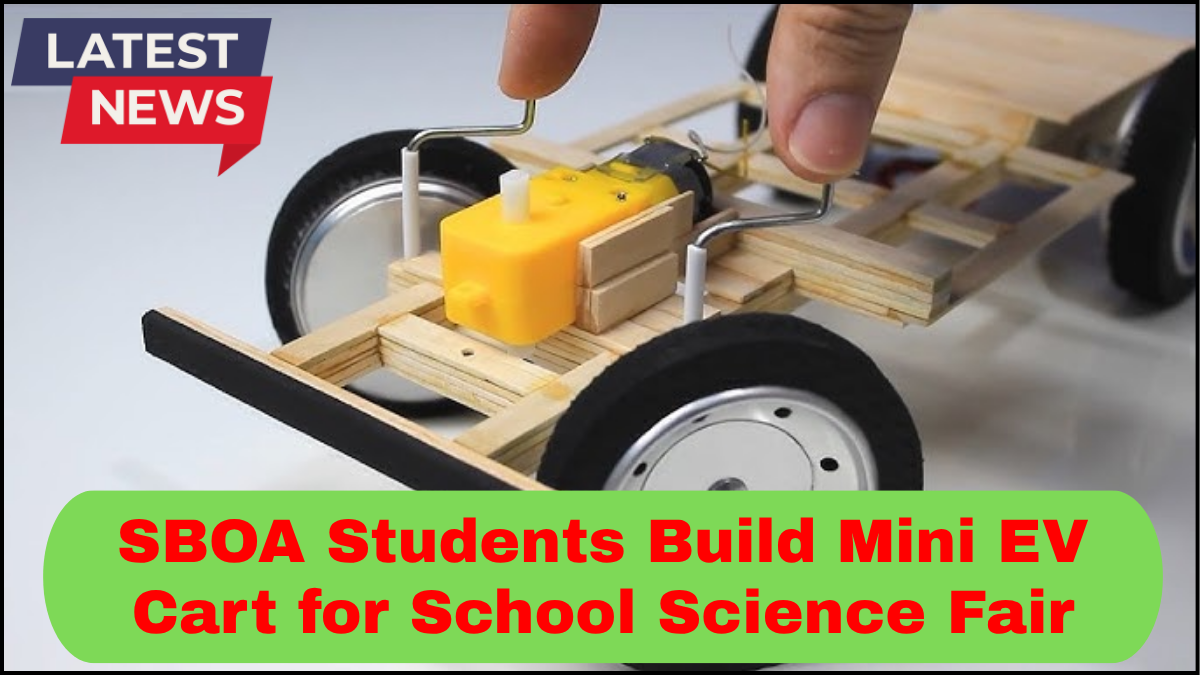In a remarkable display of school innovation, a team of bright young minds from SBOA School has successfully designed and constructed a mini electric vehicle (EV) cart as part of their annual science fair. This student-built EV cart project not only showcases their technical abilities but also underscores the growing emphasis on sustainable technology in academic institutions.

The Idea Behind the EV Cart
The motivation for the student-built EV cart project stemmed from a growing awareness of environmental issues and the increasing role electric vehicles are expected to play in the future of transportation. The student team—comprising 9th and 10th graders—wanted to create a practical, functioning prototype that would reflect their understanding of green energy solutions.
After brainstorming sessions and research, the idea of building a mini EV cart emerged. The goal was to create a battery-powered vehicle that could carry two people, move efficiently within the school premises, and serve as a model for future green mobility projects.
Planning and Design Process
The students began by drafting multiple sketches and blueprints. They focused on keeping the design lightweight yet sturdy enough to carry passengers. With guidance from their physics and engineering mentors, the team selected eco-friendly materials and lightweight metals to construct the chassis.
The electrical system was central to the design. Students opted for a 48V battery system paired with a DC motor to drive the wheels. They engineered a custom-built circuit to regulate voltage, manage safety features, and allow smooth acceleration and deceleration.
The EV cart features:
-
A rechargeable lithium-ion battery with a 3-hour runtime
-
A steel-aluminum hybrid frame to balance durability and weight
-
Rubberized tires designed for smooth indoor and outdoor surfaces
-
LED lighting for enhanced visibility
-
A regenerative braking system for added energy efficiency
Learning by Doing: Core Takeaways
The student-built EV cart project was more than just a science fair entry; it became a real-world learning lab. Students engaged in:
-
Team-based problem-solving: Dividing roles in design, electrical integration, and testing phases
-
Hands-on technical training: Using tools, soldering components, and assembling a functioning circuit
-
Sustainability education: Applying classroom knowledge to an actual solution for real-world environmental challenges
This project also provided exposure to interdisciplinary learning—combining physics, environmental science, and mechanical engineering in a cohesive, applied format.
Support and Mentorship
The school’s science department played a crucial role by facilitating access to tools, resources, and external technical mentors. Local engineers and alumni working in renewable energy sectors visited the team during the build phase, providing insights into the latest trends in EV technology and encouraging innovation.
In addition, the school administration supported the team financially, allocating a dedicated budget for the purchase of batteries, wiring, and other key components. This kind of institutional backing made the project not only possible but also impactful.
Public Display and Future Potential
The mini EV cart was unveiled at the school science fair to enthusiastic applause. Parents, teachers, and local dignitaries praised the students’ effort, especially the project’s relevance to ongoing conversations around clean energy and green transportation.
The cart wasn’t just static; students demonstrated its functionality by driving it across a designated course on school grounds. The project has already inspired the administration to consider using the cart for official campus transport, highlighting its practical viability.
Looking ahead, the students are planning to enhance the model with solar panels, better speed control, and app-based diagnostics—taking the next step in their innovation journey.
Why This Matters
This initiative is a shining example of school innovation at its best. In an age when educational institutions are often challenged to keep pace with rapid technological advancement, SBOA students have proven that with curiosity, teamwork, and the right mentorship, even young minds can contribute to sustainable development.
More importantly, the student-built EV cart project demonstrates how academic learning can be transformed into action—empowering students to become inventors, not just learners.
FAQs
Q1: What inspired the students to build an EV cart?
The idea was born from a desire to address environmental concerns and learn about electric mobility through a hands-on, practical project.
Q2: What was the biggest challenge the team faced?
Managing the electrical circuitry and ensuring battery safety were the most complex parts, requiring careful planning and testing.
Q3: Is the EV cart fully functional?
Yes, the cart is fully operational and was demonstrated live during the school science fair.
Q4: What makes this project unique?
It’s a fully student-designed and student-built EV cart that integrates environmental consciousness with engineering, supported by institutional mentorship and real-world application.
Q5: What’s next for the team?
They plan to integrate solar power, improve the drive system, and potentially create a newer version for broader use within the school.
click here to learn more